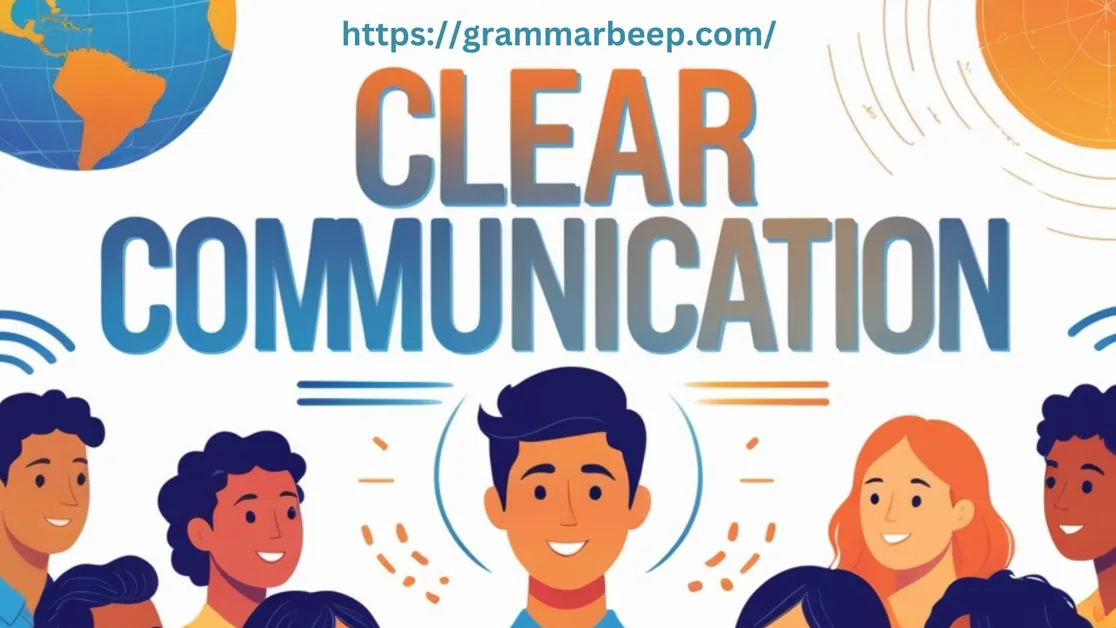20 Other Ways to Say “Clear Communication” proves that powerful expression is more than just delivering words — it’s about connecting minds with clarity and intent. In every workplace meeting, client call, or heartfelt conversation, the way you shape your message determines how well it’s received. Expanding your vocabulary with alternatives like effective communication and articulate expression helps you speak with confidence and purpose. These expressions refine your message delivery, strengthen relationships, and ensure that every word you share lands exactly as you intend.
In every part of life — whether you’re leading a meeting, writing an email, or having a heart-to-heart — clear communication is the thread that keeps everything together. It’s how ideas travel without distortion, how teams stay aligned, and how relationships grow stronger. Yet, saying “clear communication” repeatedly can sound repetitive and unimaginative. Fortunately, English offers plenty of richer, more nuanced alternatives that can elevate your writing, improve message delivery, and make your language sound more polished.
Articulate Expression
When someone speaks or writes with articulate expression, their thoughts unfold logically and elegantly. It means sharing ideas so clearly and fluently that even complex topics feel easy to digest.
Professional Example – Email:
Subject: Presentation Follow-Up
Hi Michael,
Your articulate expression during yesterday’s strategy meeting helped everyone grasp the new project direction quickly. The way you simplified technical jargon into plain terms was particularly helpful for the marketing team.
Best,
Sofia
Use this when you want to emphasize eloquence, especially in business communication or academic communication where communication skills matter.
Transparent Dialogue
Transparent dialogue is about openness — where intentions, expectations, and ideas are shared honestly. It builds communication trust and removes guesswork from conversations.
Personal Example – Conversation:
“I value our transparent dialogue, Anna. Being upfront about how we feel makes it easier to work through challenges without resentment.”
This phrase works well in team collaboration or conflict resolution communication, where promoting transparency through dialogue strengthens trust and understanding.
Straightforward Communication
Sometimes, clarity means getting straight to the point. Straightforward communication cuts through fluff and avoids unnecessary complexity — perfect when time is short or the message must be crystal clear.
Professional Example – Workplace Memo:
Subject: Office Hours Change
Team,
Starting Monday, our new office hours will be 9 AM – 5 PM. We appreciate your punctuality.
– HR Department
This is ideal in workplace communication or any business setting where communication efficiency matters and you want to avoid misinterpretation in communication.
Check out this: 20 Other Ways to Say “Short End of the Stick”
Unambiguous Exchange
When legal or contractual clarity is critical, nothing beats an unambiguous exchange. It ensures no room for misunderstanding or loopholes.
Professional Example – Legal Notice:
“This agreement represents an unambiguous exchange of terms. Both parties have reviewed and accepted all conditions without reservation.”
Use it in legal communication, policy writing, or compliance documents where communication accuracy and communication precision are essential.
Lucid Conveyance
Lucid conveyance turns complicated instructions into something anyone can follow. It’s about simplifying complex information.
Educational Example – Training Session:
“Your lucid conveyance of the new software workflow helped even the least tech-savvy employees feel confident using it.”
It’s especially valuable in instructional communication, training materials, or teaching contexts where educational clarity is the goal.
Effective Communication
This is a foundational phrase that captures the heart of how to communicate clearly. Effective communication ensures your message achieves its intended purpose and produces results.
Professional Example – Customer Service Email:
Subject: Resolving Your Inquiry
Hello James,
We believe effective communication is key to excellent service. Here’s a detailed breakdown of the solution we’re implementing for your issue.
Best regards,
Support Team
Because of its broad nature, you can use it in any context — from strategic communication and marketing messaging to team communication and personal conversations.
Concise Messaging
In a world flooded with information, concise messaging is a breath of fresh air. It means delivering concise messages that are short yet powerful.
Marketing Example – Social Media Post:
“Your morning coffee, delivered. Order now and start your day right.”
This style is crucial in marketing messaging and advertising, where communication simplicity and speed of understanding make or break a campaign.
More for you: 21 Other Ways to Say “Good Vibes”
Crystal-clear Communication
When you want to emphasize absolute clarity, crystal-clear communication does the job. It suggests messages so clear they leave no doubt.
Team Example – Project Brief:
Subject: Launch Timeline Update
Team,
For successful execution, we need crystal-clear communication across departments. Please ensure all updates are shared daily.
It’s powerful in collaborative communication or decision-making processes, where even small misunderstandings can derail a project.
Open Communication
Open communication creates space for honesty, questions, and feedback. It nurtures communication openness and builds trust and transparency.
Personal Example – Relationship Chat:
“I want us to practice open communication about finances so we can plan for the future together.”
This phrase thrives in organizational culture, leadership, and relationship dynamics, promoting inclusive communication and participatory dialogue.
Precision in Messaging
When every word matters — such as in marketing or legal contexts — precision in messaging is the gold standard. It’s about communicating with precision to achieve specific results.
Professional Example – Branding Email:
Subject: Brand Voice Update
Hi Team,
Our new tone guide emphasizes precision in messaging to ensure our campaigns resonate with the right audience.
– Marketing Director
Use this when communication outcomes depend on the exactness of language.
For your interest: 20 Professional Ways to Say ‘No Pressure’
Direct Discourse
Direct discourse eliminates vagueness. It’s perfect when you need to assert a stance without hedging or sugarcoating.
Negotiation Example – Meeting Statement:
“Let me offer some direct discourse: we can’t agree to the terms unless delivery timelines improve.”
This style suits negotiations, debates, and feedback and discussion sessions where being forthright is essential.
Clarity in Communication
This phrase captures the essence of everything in this guide — clarity in communication ensures your message lands exactly as intended.
Professional Example – Project Recap:
“To maintain clarity in communication, all updates will be summarized in a shared document.”
It’s a versatile term for business communication, project documentation, and organizational culture policies.
Transparent Interaction
Transparent interaction emphasizes openness in two-way conversations. It goes beyond just sharing information — it’s about honesty in responses and decisions.
Workplace Example – Performance Review:
“We aim for transparent interaction during reviews so everyone understands expectations and growth paths.”
This fosters communication transparency and builds communication trust in professional relationships.
Clear Messaging
Clear messaging focuses on the simplicity of expression. It’s about stripping away clutter and focusing on what matters most.
Marketing Example – Product Launch:
“Our campaign relies on clear messaging so customers instantly understand what makes this product unique.”
It’s essential in branding, PR, and marketing where communication effectiveness drives results.
Straight-Talking Dialogue
A more casual alternative, straight-talking dialogue communicates honesty and assertiveness without being harsh.
Personal Example – Friendship Talk:
“I appreciate our straight-talking dialogue — we don’t dance around issues, and that keeps our bond strong.”
Use it in interpersonal communication or conflict resolution where authenticity matters more than polish.
You might also like: 21 Other Ways to Say “Bro”
Cohesive Communication
Cohesive communication ensures everyone stays aligned and moving toward the same communication goals. It binds ideas and actions into a shared understanding.
Team Example – Project Coordination:
“Our success relies on cohesive communication between departments to avoid overlap and delays.”
It’s ideal for team communication, project management, and collaborative communication scenarios.
Purposeful Communication
Purposeful communication reminds you that communication isn’t just about talking — it’s about driving action and results.
Leadership Example – Strategy Session:
“Let’s keep our focus on purposeful communication so every message moves us closer to our mission.”
Perfect for strategic communication and business settings where intent matters as much as clarity.
Unclouded Expression
This elegant term highlights speech or writing that’s clear, pure, and easy to follow — free from jargon or confusion.
Educational Example – Lecture Feedback:
“The professor’s unclouded expression made a complex theory feel surprisingly approachable.”
It works well in academic communication and instructional clarity contexts.
Explicit Exchange
Finally, explicit exchange stresses that nothing is implied or left unsaid. Everything is spelled out clearly and deliberately.
Legal Example – Contract Clause:
“This clause represents an explicit exchange of obligations between both parties.”
Use this in legal communication or technical writing where ambiguity can lead to disputes.
Plainspoken Communication
Sometimes, simplicity is power. Plainspoken communication avoids fancy language and delivers the truth plainly and honestly.
Personal Example – Advice:
“I value your plainspoken communication — you always say exactly what you mean.”
It’s perfect for everyday conversations, feedback, and coaching where communication simplicity matters most.
Synonyms for “Clear Communication”
| Alternative Phrase | Best Used For | Tone |
|---|---|---|
| Articulate Expression | Presentations, writing, public speaking | Formal/Professional |
| Transparent Dialogue | Team discussions, conflict resolution | Open/Collaborative |
| Straightforward Communication | Workplace policies, instructions | Clear/Direct |
| Unambiguous Exchange | Legal documents, contracts | Precise/Formal |
| Lucid Conveyance | Teaching, training, presentations | Educational |
| Effective Communication | Customer service, leadership | Broad/General |
| Concise Messaging | Marketing, emails, campaigns | Short/Impactful |
| Crystal-clear Communication | Team projects, collaborative work | Emphatic/Assertive |
| Open Communication | Feedback sessions, relationships | Inclusive/Trust-building |
| Precision in Messaging | Marketing, PR, branding | Strategic |
| Direct Discourse | Debates, negotiations | Assertive |
| Clarity in Communication | General workplace use | Versatile |
| Transparent Interaction | Customer relations, leadership | Honest/Trust-focused |
| Clear Messaging | Marketing, announcements | Simple |
| Straight-Talking Dialogue | Negotiations, feedback | Bold/Informal |
| Cohesive Communication | Team collaboration, projects | Unified |
| Purposeful Communication | Strategy meetings, planning | Intentional |
| Unclouded Expression | Presentations, education | Elegant |
| Explicit Exchange | Legal, academic, policy documents | Technical/Formal |
| Plainspoken Communication | Everyday conversations, instructions | Natural/Relatable |
FAQs
What is the main goal of clear communication?
The main goal is to ensure your message is understood exactly as you intend without confusion.
How can clear communication improve teamwork?
It builds communication trust and keeps everyone aligned on goals and responsibilities.
Can using synonyms make communication more engaging?
Yes, varied phrases like lucid conveyance and direct discourse make your speech and writing more dynamic.
Is clear communication important in personal relationships?
Absolutely, it prevents misunderstandings and strengthens emotional connections.
How does clear communication support decision-making?
It provides accurate information quickly, leading to smarter and faster choices.
Conclusion
20 Other Ways to Say “Clear Communication” shows that choosing the right phrase transforms how others understand you. Using expressions like concise messaging and transparent dialogue keeps your conversations clear and impactful. Strong communication skills build trust, improve teamwork, and help ideas flow without confusion. Mastering these alternatives turns every message into a tool for connection and understanding, whether you’re speaking in a meeting or sharing thoughts with someone important.

Zoey Alba is an experienced blogger and language enthusiast with a passion for helping readers master the art of grammar. With years of expertise in writing, editing, and content creation, Zoey shares practical tips and insightful advice to make grammar accessible for all. When she’s not writing, Zoey enjoys reading, learning new languages, and inspiring others to write with confidence.
